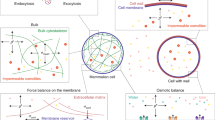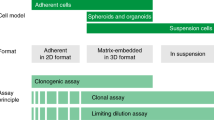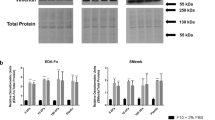Abstract
VARIOUS aspects of a cell's growth cycle can be manipulated in tissue culture. For example, the initiation of DNA synthesis and, in some cases, culture growth, can be enhanced by serum1 and platelet2 components, polypeptides purified from growth-conditioned medium3 and urine4, insulin5, corticosteroids6, prostaglandins7, cyclic nucleotides (see, for example, ref. 8) and proteolytic enzymes9. In addition, at least three purified proteins can initiate DNA synthesis in fibroblast-like cells—nerve growth factor10, epidermal growth factor11 and fibroblast growth factor12,13. Disturbance of the culture medium directly over the cultured cells also induces DNA synthesis14. Fibroblast-like cells have been used in most of these studies, and they grow tightly associated with the culture dish and are strongly anchorage dependent for division15,16. Given the strong anchorage dependence of the test cells, two alternatives could account for the induction of DNA synthesis and growth by the diversity of conditions and “factors” outlined above. The first would ascribe the effects of these compounds to interactions on the cell surface with a suitable receptor. These are hormone-like interactions, thought to be exemplified by compounds such as insulin and purified growth factors1. The second alternative represents interactions which function directly through alterations of cell anchorage. For example, the growth stimulating effects of the proteases are presumably affected by modification of the cell–substratum (anchorage) interaction17. To distinguish between these two alternatives, it should be sufficient to assay the effects of serum and a purified growth factor on the initiation of DNA synthesis in an anchorage-dependent cell line, and on a variant which grows in suspension culture. If serum and the growth factor were equally effective in both cell lines, then a disturbance in anchorage could not account for the mitogenic activity, ruling out the second alternative. The first, hormone-like, mechanism, however, would be excluded if the growth factor was unable to induce DNA synthesis in the cells grown in suspension. The following experiments support this latter possibility by showing that fibroblast growth factor12,13 does not affect the growth of myoblast cells grown in suspension culture.
This is a preview of subscription content, access via your institution
Access options
Subscribe to this journal
Receive 51 print issues and online access
$199.00 per year
only $3.90 per issue
Buy this article
- Purchase on Springer Link
- Instant access to full article PDF
Prices may be subject to local taxes which are calculated during checkout
Similar content being viewed by others
References
Holley, R. W., Nature, 258, 487–490 (1975).
Kohler, N., and Lipton, A., Expl Cell Res., 87, 297–301 (1974).
Smith, G. L., and Temin, H. M., J. Cell Physiol., 84, 181–192 (1974).
Cohen, S., and Carpenter, G., Proc. natn. Acad. Sci. U.S.A., 72, 1317–1321 (1975).
Yarnell, M. M., and Schnebli, H. P., J. Cell Sci., 16, 181–189 (1974).
Thrash, C. R., and Cunningham, D. D., Nature, 242, 399–401 (1973).
Jimenez de Asua, L., Clingan, D., and Rudland, P. S., Proc. natn. Acad. Sci. U.S.A., 72, 2724–2728 (1975).
Seifert, W. E., and Rudland, P. S., Nature, 248, 138–140 (1974).
Sefton, B., and Rubin, H., Nature, 227, 843–844 (1970).
Greene, L. A., Tomita, J. T., and Varon, S., Expl Cell Res., 64, 387–395 (1971).
Rose, S. P., Pruss, R. M., and Herschman, H. R., J. Cell Physiol., 86, 593–598 (1975).
Armelin, H. A., Proc. natn. Acad. Sci. U.S.A., 70, 2720–2706 (1973).
Gospodorowicz, D., Nature, 249, 123–127 (1974).
Stoker, M. G. P., Nature, 246, 200–203 (1973).
Shin, S., Freedman, V. H., Risser, R., and Pollack, R., Proc. natn. Acad. Sci. U.S.A., 72, 4435–4439 (1975).
Otsuka, H., and Moskowitz, M., J. Cell Physiol., 86, 379–388 (1975).
Pollack, R., and Rifkin, D., Cell, 6, 495–560 (1975).
Yaffe, D., Proc. natn. Acad. Sci. U.S.A., 61, 477–481 (1968).
Tarikas, H., and Schubert, D., Proc. natn. Acad. Sci. U.S.A., 71, 2377–2381 (1974).
Holley, R. W., and Kiernan, J. A., Proc. natn. Acad. Sci. U.S.A., 71, 2908–2912 (1974).
Gospodorowicz, D., J. biol. Chem., 250, 2515–2522 (1975).
Huang, D., and Cuatrecasas, P., J. biol. Chem., 250, 8251–8259 (1975).
Blumberg, P., and Robbins, P., Cell, 6, 137–147 (1975).
Rubin, H., Proc. natn. Acad. Sci. U.S.A., 72, 1676–1680 (1975).
Schubert, D., Humphreys, S., de Vitry, F., and Jacob, F., Devl Biol., 25, 514–522 (1971).
Author information
Authors and Affiliations
Rights and permissions
About this article
Cite this article
SCHUBERT, D., LACORBIERE, M. & WATSON, J. Growth regulation of cells grown in suspension culture. Nature 264, 266–267 (1976). https://doi.org/10.1038/264266a0
Received:
Accepted:
Issue Date:
DOI: https://doi.org/10.1038/264266a0
Comments
By submitting a comment you agree to abide by our Terms and Community Guidelines. If you find something abusive or that does not comply with our terms or guidelines please flag it as inappropriate.



